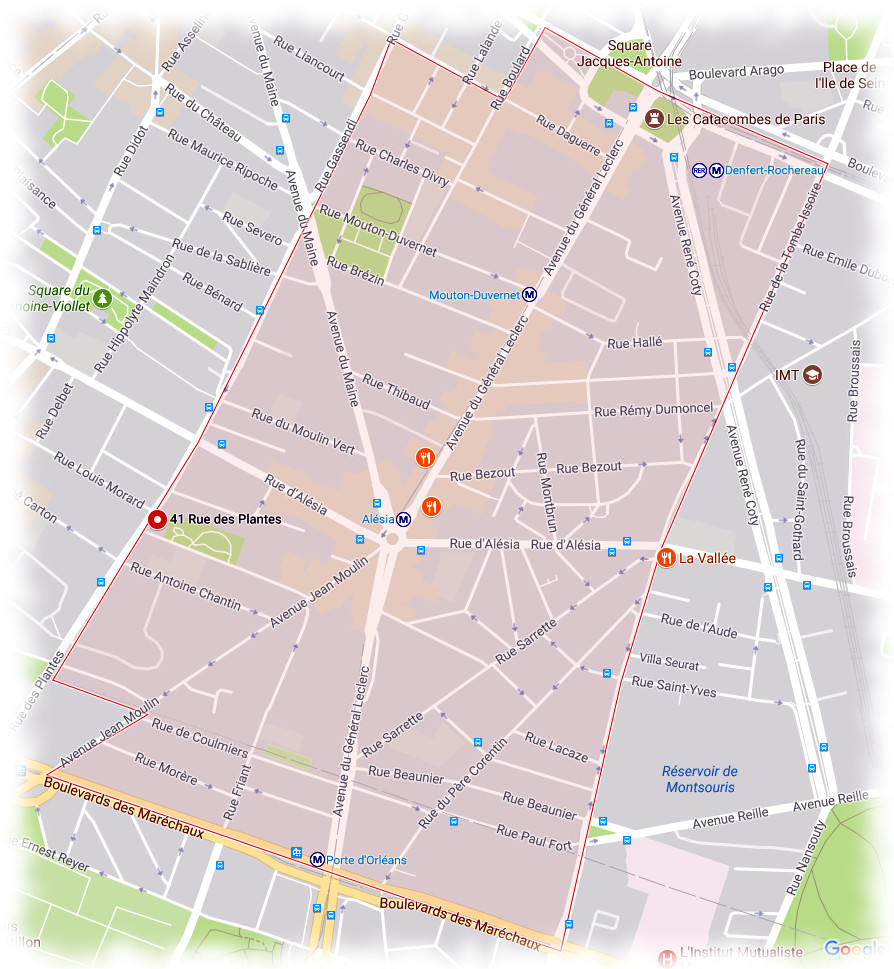Quartier du Petit-Montrouge

The quartier du Petit-Montrouge is number 55 of the 80 quartiers administratifs (administrative districts) in Paris. It lies in the 14th Arrondissement, in the south of the capital. It owes its name to the adjacent commune of Montrouge, of which it formed a part before 1860. It is familiar as the quartier Alésia, from the name of a street that bisects it and from the principal Métro station that serves it, although the quartier Alésia does not exactly overlap the quartier du Petit-Montrouge.
Location
The quartier du Petit-Montrouge is delimited by Rue Daguerre and Boulevard Saint-Jacques to the north, by Rue de la Tombe-Issoire to the east, by Boulevard Romain Rolland to the south, and Avenue de la Porte de Châtillon and Rue des Plantes and Rue Gassendi to the west.
It is bordered to the north by the quartier de Montparnasse, to the east by the quartier du Parc de Montsouris, to the south by the commune of Montrouge, and to the west by the quartier de Plaisance.
History
The quartier du Petit-Montrouge was created at the same time as the 14th Arrondissement in 1860, when Paris annexed a part of the commune of Montrouge. Montrouge was originally divided into two distinct sectors, Grand-Montrouge (corresponding to the current commune of Montrouge) and Petit-Montrouge, the church housing development launched around 1840, the centre of which is now called Place Michel Audiard. Still at this site today is a building in the French Directory architectural style, which was the old city hall annex of Montrouge.
Geography
From a topographical point of view, Petit-Montrouge is situated on a plateau atop the hillsides of the left bank of the Bièvre River. Overall it is flat. The centre of the quartier (as well as the centre of the arrondissement) is Place Hélène et Victor Basch, better known as Carrefour Alésia. That is the point of convergence of the old routes of Chartres and Orléans, from which the flow of traffic is redistributed to the whole of the left bank of the capital by Rue d'Alésia, Avenue du Maine, and Avenue du Général Leclerc (which constitutes the backbone of the quartier). A network of more or less perpendicular streets serves the entire quartier, testifying to a belated urbanization.
Urban Planning (or lack thereof)
The belated urbanization of the quartier (after 1840), together with the availability of land, led to a great architectural diversity. The residential areas are composed of buildings of all styles. There is no great number of Haussmanian edifices, the quartier having largely been untouched by Second French Empire urban redevelopment. They are mostly found by the town hall and on Rue Alésia. Entirely Haussmanian streets, like Rue du Lunain, are rather rare. Façades in plaster are more common, testifying to the working class past of the quartier. Buildings of the 1930s are more present in the south, particularly in the ancient zone of fortifications. Finally the post-war architecture is also well represented, for better and for worse. One of the characteristics of the quartier is the importance of the individual home. Many plots were built only in façade, leaving the place for city houses or artists' workshops, often adorned with private gardens, invisible from the street. This type of construction is also found in the dead end streets (the "villas"), occasionally with real architectural treasures. Certain streets, like Rue Bezout, form an authentic architectural museum offering to the visitor a variety of styles, sizes, eras of construction, and volumes. Concentrated in this quartier are also numerous Faubourgian buildings, predating the 1860 annexation, of one or two storeys, rare in the Parisian landscape. Office buildings are almost absent from this residential and shopping quartier, with the notable exception of the extreme south of the quartier, bordering on the commune of Montrouge.